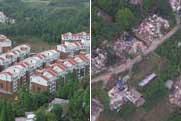China
Full Text: China´s National Defense in 2006
Development of the Services and Arms
The Army is speeding up the upgrading and informationization of its active main battle equipment to build a new type of ground combat force that is lean, combined, agile and multi-functional. Priority is given to building Army aviation, light mechanized and information countermeasures units. The share of the armored component in the Army combined combat forces has been further raised. The artillery and air defense component has fielded new types of cannons, field antiaircraft missiles, reconnaissance early warning radars, fire-control systems, and intelligence and command systems, and increased the proportion of ground-to-air missiles to antiaircraft guns. The engineering component has grown in step with the main combat arms, and improved its capabilities of accompanying support and precision support. The anti-chemical component has established a preliminary nuclear, biological and chemical (NBC) protection system tailored to joint operations, and greatly increased its capabilities of rapid NBC protection, NBC emergency rescue and operations against NBC terrorism. The communications component has enhanced the building of platforms for general-purpose information transmission and processing, C2 systems and spectrum management systems, and raised communications and information support capabilities.
Founded in 1986, the Army aviation arm has a three-level (general headquarters/departments, theaters of war and first-line task groups) administration system. Equipped mainly with armed helicopters, transport helicopters and service helicopters, it carries out air strike, air landing, airlifting and battlefield service support operations. The Army aviation arm works to strengthen its capabilities of rapid power projection, precision strike, long-range assault and support.
The Navy is working to build itself into a modern maritime force of operation consisting of combined arms with both nuclear and conventional means of operations. Taking informationization as the goal and strategic focus in its modernization drive, the Navy gives high priority to the development of maritime information systems, and new-generation weaponry and equipment. Efforts are being made to improve maritime battlefield capabilities, with emphasis on the construction of relevant facilities for new equipment and the development of combat support capabilities. The Navy is endeavoring to build mobile maritime troops capable of conducting operations under conditions of informationization, and strengthen its overall capabilities of operations in coastal waters, joint operations and integrated maritime support. Efforts are being made to improve and reform training programs and methods to intensify training in joint integrated maritime operations. The Navy is enhancing research into the theory of naval operations and exploring the strategy and tactics of maritime people's war under modern conditions.
The Air Force is working to build an informationized air fighting force with both offensive and defensive capabilities. It is reducing the number of combat aircraft, giving priority to the development of new fighters as well as air and missile defense weapons. It is working to enhance command and control systems. It stresses mission-oriented and confrontational training, increasing combined tactical training of different arms and aircraft types, and conducts training in flying refitted new aircraft and using new weaponry and equipment in an active and stable way. Air Force pilot training is conducted at flying colleges, training bases and combat units in five phases, namely, basic education, primary flying, advanced flying, refitted combat aircraft flying and tactical flying. Aviation units mainly conduct training in counter-air operations, air-to-ground attacks and joint operations. Pilots fly training hours are commensurate with the tasks assigned to pilots.
The Second Artillery Force is striving to build a streamlined and effective strategic force with both nuclear and conventional capabilities. It is quickening its steps to raise the informationization level of its weaponry and equipment systems, build an agile and efficient operational command and control system, and increase its capabilities of land-based strategic nuclear counterstrikes and precision strikes with conventional missiles. It is improving the construction of its battlefield system, and associated logistics and equipment, and raising the cost-effectiveness of integrated support. It is deepening the reform of training, enhancing integrated training, using scientific and technological achievements to raise training quality. It is strengthening the safety management and control mechanism of nuclear missiles, and improving the relevant rules and regulations and technical preventive measures as well as emergency steps for handling nuclear accidents. The Second Artillery Force is equipped with surface-to-surface strategic missiles and tactical operational missiles of various types.



